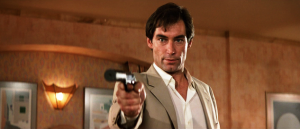
In broad terms, the Timothy Dalton era of James Bond films dispatched with the cheeky humor, super-heroics, and comic-book villains of the Roger Moore era, and attempted to reground Ian Fleming’s beloved character in the real world.
In The Living Daylights, for instance, Dalton’s Bond battled Whitaker (Joe Don Baker), an egotistical U.S army officer clearly patterned on the disgraced Lt. Colonel, Oliver North, in a plot involving an illegal weapons-for-drugs deal and reflecting the Iran-Contra Scandal.
And in Licence to Kill, Bond combated a Pablo Escobar-type drug lord, Sanchez (Robert Davi) “south of the border.”
Both villains seemed ripped from contemporary headlines, and were a far-cry from the likes of Stromberg (The Spy Who Loved Me) or Drax (Moonraker)…men seeking to cause global Armageddon and create a “master race” under the sea, and in outer space, respectively.
The Bond films of the Timothy Dalton Age — arriving shortly after President Reagan’s first public comments on AIDS on March 31st, 1987 — also played down 007’s penchant for womanizing, and stressed realistic, even gritty action instead.
In a very real sense then, both The Living Daylights and Licence to Kill forecast the 21st century direction of the beloved franchise, dealing explicitly with Bond’s internal angst, and occasional obsession with revenge.
Before Daniel Craig went that very route, Dalton’s Bond blazed the trail.
Harking back to the literary source material, Dalton’s James Bond was frequently on edge, and not at all happily ensconced on Her Majesty’s Secret Service. Indeed, much of The Living Daylights concerns Bond’s freedom (or lack thereof…) to interpret orders as he sees fit and not execute them mindlessly, as a martinet.
And if “M” — his superior at M.I. 6 – didn’t t like his interpretation of said orders, well… he could fire Bond.
Indeed, Bond would be just fine with that outcome, as 007 himself notes caustically early in The Living Daylights.
Reflecting on the character and franchise re-boot of the Timothy Dalton age, I submit below my choices for five great character moments from this span in the franchise’s history.
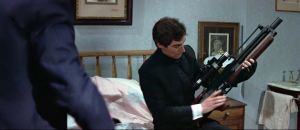
From The Living Daylights: Bond violates orders, and doesn’t kill a KGB sniper when that sniper is revealed to be… a beautiful woman.
Following the film’s opening credits, we learn that Bond has been tasked with the assassination of a KGB sniper in Czechoslovakia, and we meet his ally, the officious, by-the-books Saunders (Thomas Wheatley).
Without emotion, Bond prepares for the task of murder. We see Bond adjust his clothes (to make it harder to see him in the light…), and load his weapon. He is all-business. But then Bond is surprised to see that the “KBG sniper” is actually a beautiful woman: an orchestra cellist: Kara Milovy (Maryam D’Abo).
Rather than follow through with his orders and kill a woman who is not a professional, Bond shoots the weapon out of Kara’s hands, keeping her alive.
Saunders complains. “You missed…deliberately!” But Bond is not a mindless murderer, and he knows a professional when he sees one.
This scene works so beautifully because it establishes three important character qualities about the “New” Bond.
First, he is often assigned to carry out monstrous acts, including assassination in his role as an agent, a task it is difficult to visualize Roger Moore’s Bond undertaking. Bond is a glorified murderer, essentially.
Secondly, although he is frequently tasked with murder, Bond still boasts a code of ethics, and the wisdom to question his orders when his gut tells him something is amiss.
And finally, we understand that Bond still has an eye for the ladies. He may have not killed Milovy because of her status as a non-professional, but the fact that she is a beautiful woman may just have factored some into his equation as well.
This is a perfect character moment in the Dalton re-boot because it expresses, with one simple act, three important qualities about 007.
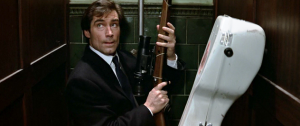
From The Living Daylights: Bond disposes of incriminating evidence against Kara Milovy and (without words) puts together the pieces of a puzzle.
Early in the film, Bond follows Kara Milovy in Bratislava, and trails her. Sharing the same tram with her, he sees the cellist picked up and arrested by Soviet General Leonid Pushkin (John Rhys-Davies). Kata leaves her cello case on the tram, and Bond takes it. He rides the tram to the end of the line and takes her case into a rest-room stall, where he finds that there is no musical instrument inside, but rather the rifle she used in her capacity as a “sniper.”
Bond discovers the gun was loaded with blanks, and that Kara, therefore, is not merely a pawn, but a patsy. Her lover and would-be defector, Koskov (Jeroen Krabbe) intended for her to die.
In this scene, Bond’s human instinct — to help Kara evade charges of murder and treason at KGB HQ — overrides his killer instinct. He disposes of the evidence, and meets Kara, and there’s a sort of chivalry to his actions that reveals something of the man’s essential character.
Perhaps more to the point, without uttering a word or guiding the viewer through his thought process, Bond determines who the real “bad player” in this scenario is. And it isn’t Kara…
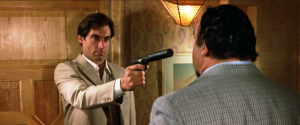
From The Living Daylights: Bond violates orders again, and doesn’t kill General Pushkin following the murder of Saunders.
For the second time in The Living Daylights, we see that Bond is more than a mindless assassin.
Instead, he is a man in the field who must think on his feet, and constantly battle his own instincts and emotions. When Saunders is murdered, presumably by Pushkin (in the general’s campaign of “Smiert Spionam,”) Bond flies into a rage. He becomes wantonly emotional and angry, and his emotions nearly push him to do the wrong thing. Pushkin is not the real villain here, and killing him would play into Koskov’s hands.
Saunder’s death is expressly designed, however, to push Bond over the edge, to make him act rashly…and to not think.
With a full head of steam behind him, Bond plans and nearly executes the murder of Pushkin, and in the process acts as mercilessly and heartlessly as we have ever seen the character. Bond uses Pushkin’s mistress as a decoy, and then roughly man-handles the Russian general. He prepares to execute Pushkin, giving him instructions to put his hands behind his head…but something holds Bond back…some sense of niggling, internal doubt, perhaps.
Eventually, Bond does the right thing and lets Pushkin live, but unlike the Bond of the Roger Moore Era, who was written as “true blue,” essentially, there’s the very real sense in this scene that 007 could be pushed over the edge, and be manipulated by his enemies.
This Bond is indeed more “dangerous” (as the movie’s ads told us…) because he has the capacity to act impulsively and emotionally, and not think things through. This is a facet of Dalton’s portrayal that I very much admire. He plays Bond as a human being who makes mistakes, and who reacts to his dangerous environs not with humor or an arched eyebrow, but with genuine emotions.
And again, it would be easy for Bond simply not to think at all in this situation, to mindlessly execute Pushkin, since that is his assigned task. He could always claim he was just following orders. But he doesn’t take the easy away out.
Instead, harking back to his code of ethics, Bond heeds an inner voice, and chooses a different path. He pulls himself back from the precipice.
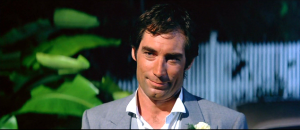
From Licence to Kill: Bond refuses Della’s (Priscilla Barnes) garter belt after her wedding, aware of what it signifies.
Following Della’s wedding to Felix Leiter (David Hedison), Bond prepares to leave Florida. Before he goes, however, Della wants to give him her garter. This present is part of a tradition which suggests that James will be the next man to get married.
Quietly, with little expression, Bond simply says “no,” and notes that it is “time” he left. He walks away, and Della throws him the garter anyway, which he reluctantly catches.
When Della asks Felix if she did something wrong, he tells his new wife that James was married once…a long time ago.
This moment not only harks back to On Her Majesty’s Secret Service (1969) and Tracy’s (Diana Riggs) tragic death, it establishes one reason why Bond never makes a “real” connection (beyond sex) with the women he encounters. He is still in mourning. He knows — and will always know — that Tracy was the one for him, and that there is no other.
The great thing about this scene is that Timothy Dalton takes the opportunity to underplay it. Instead of reacting emotionally or angrily, he just says “no” quietly, and continues on his way, leaving Felix to do the explaining to both Della and the viewers.
There’s a lot of heartbreak, clearly, behind his negative utterance.
This scene not only explains Bond’s lifestyle choices in the years after Tracy, it sets-up perfectly the motivation for his obsession with Sanchez in Licence to Kill. When Felix loses Della on his wedding night — as Bond lost Tracy on his — nothing can stop him from exacting revenge.
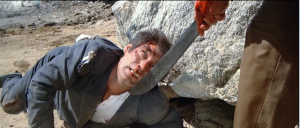
From Licence to Kill: Bond asks Sanchez if he wants to know “why…”
I rank Robert Davi’s Sanchez as among the very best of the Bond villains, and that’s because, simply, he is both “real” and nearly Shakespearean in terms of his tragic character flaw.
Sanchez expects “100 %” loyalty from everyone in his organization, but has great difficulty returning that loyalty. Bond ruthlessly exploits that individual weakness throughout the film, rending Sanchez from his loyalists, and in the process, bringing the villain low.
At the end of the film, Bond is all but defeated. He is bloodied and wounded in a way that would have seemed unthinkable in the Roger Moore era. Bond has no guns, and no strength with which to fight back.
Sanchez brutally puts a machete to his forehead to kill him, and — thinking fast — Bond uses that moment to play on Sanchez’s Persian flaw.
After Sanchez expresses the thought that if Bond had remained loyal to him, he “could have had everything,” Bond asks him “don’t you want to know why?”
Sanchez hesitates, and Bond uses that split second of hesitation to dispatch Sanchez — already doused in gasoline — with a cigarette lighter.
This moment is perfect, in my view, because it expresses the idea that Bond is not merely a good shot, or an expert in hand-to-hand combat. He is quick on his feet, a good thinker, and it is this resource, ultimately — his mind — that gets him out of scrapes.
Bond plays on Sanchez’s psychological foible, and carries the day, showing us that even when he is down, Bond is never out.
I would have very much liked to see another Timothy Dalton Bond film, but the character’s treatment of Sanchez here is a great way to end this era, perfectly expressing James Bond’s endless resourcefulness.
Would you like to support Flashbak?
Please consider making a donation to our site. We don't want to rely on ads to bring you the best of visual culture. You can also support us by signing up to our Mailing List. And you can also follow us on Facebook, Instagram and Twitter. For great art and culture delivered to your door, visit our shop.








